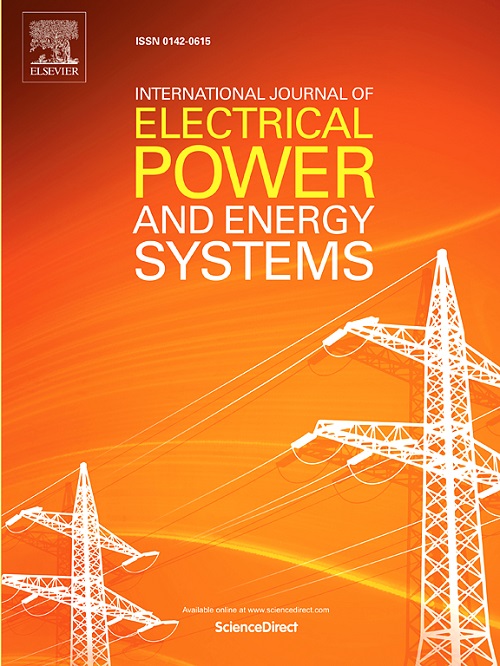GNN assisted frequency constrained unit commitment of multi-region power systems with high penetration of renewable energy sources
IF 5
2区 工程技术
Q1 ENGINEERING, ELECTRICAL & ELECTRONIC
International Journal of Electrical Power & Energy Systems
Pub Date : 2025-04-16
DOI:10.1016/j.ijepes.2025.110670
引用次数: 0
Abstract
The increasing integration of renewable energy resources (RES) into the power grid poses significant challenges in system frequency dynamics. Traditional frequency-constrained unit commitment models simplify the average system frequency and neglect the spatial characteristics of frequency dynamics, potentially underestimating the risk of contingencies. In this paper, we consider a nodal frequency response model to capture the frequency dynamics in the unit commitment problem. Nodal frequency dynamics and rate of change of frequency (RoCoF) expressions are converted into security constraints against worst contingency, which are then incorporated into the proposed muti-region frequency-constrained unit commitment (MR-FCUC) formulations. To improve the efficiency and performance of the MR-FCUC model, a decomposition algorithm is implemented to solve the proposed MR-FCUC efficiently. The subproblem of the original model confirms the frequency dynamics, and sensitivity cuts are refined based on the validation errors. Additionally, a GNN-based voltage phase angle predictor is incorporated to boost the computational efficiency of the FCUC model. Case study involving modified IEEE 24-bus and IEEE 118-bus systems illustrates the effectiveness of the proposed GNN-MR-FCUC model. Simulation results of test systems affirm that the frequency stability is guaranteed: the maximal RoCoF is mitigated within 0.5 Hz/s, and the lowest frequency nadir is maintained above 59.71 Hz.
可再生能源渗透率高的多区域电力系统的 GNN 辅助频率受限机组承诺
随着可再生能源并网程度的不断提高,对系统频率动力学提出了重大挑战。传统的频率约束单元承诺模型简化了系统平均频率,忽略了频率动态的空间特性,可能低估了意外事件的风险。在本文中,我们考虑了一个节点频率响应模型来捕捉机组投入问题中的频率动态。节点频率动态和频率变化率(RoCoF)表达式转化为针对最坏偶然性的安全约束,然后将其纳入所提出的多区域频率约束单元承诺(MR-FCUC)公式。为了提高MR-FCUC模型的效率和性能,实现了一种分解算法对所提出的MR-FCUC进行高效求解。原模型的子问题验证了频率动力学,并根据验证误差对灵敏度切割进行了细化。此外,为了提高FCUC模型的计算效率,还引入了基于gnn的电压相角预测器。针对改进的IEEE 24总线和IEEE 118总线系统的案例研究表明了所提出的GNN-MR-FCUC模型的有效性。测试系统的仿真结果表明,该系统的频率稳定性得到了保证:最大RoCoF被抑制在0.5 Hz/s以内,最低频率最低点保持在59.71 Hz以上。
本文章由计算机程序翻译,如有差异,请以英文原文为准。
求助全文
约1分钟内获得全文
求助全文
来源期刊
CiteScore
12.10
自引率
17.30%
发文量
1022
审稿时长
51 days
期刊介绍:
The journal covers theoretical developments in electrical power and energy systems and their applications. The coverage embraces: generation and network planning; reliability; long and short term operation; expert systems; neural networks; object oriented systems; system control centres; database and information systems; stock and parameter estimation; system security and adequacy; network theory, modelling and computation; small and large system dynamics; dynamic model identification; on-line control including load and switching control; protection; distribution systems; energy economics; impact of non-conventional systems; and man-machine interfaces.
As well as original research papers, the journal publishes short contributions, book reviews and conference reports. All papers are peer-reviewed by at least two referees.

 求助内容:
求助内容: 应助结果提醒方式:
应助结果提醒方式:


